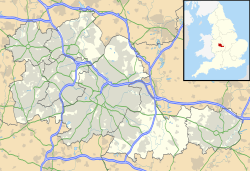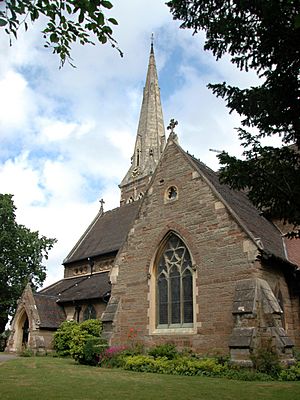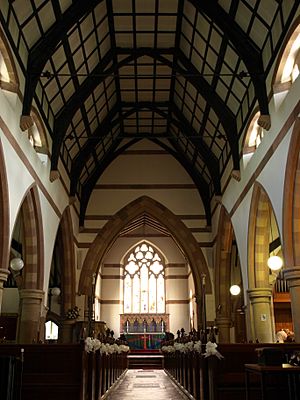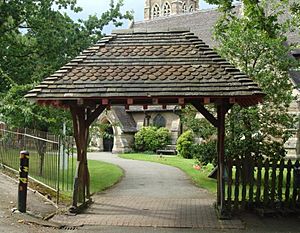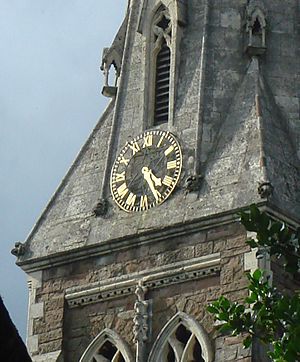St Mary's Church, Selly Oak facts for kids
Quick facts for kids St Mary's Church, Selly Oak |
|
|---|---|
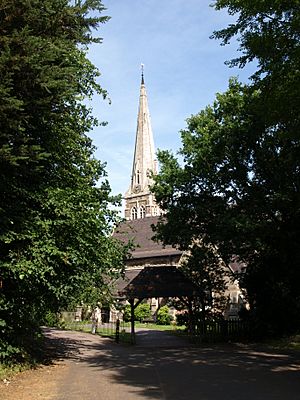
St. Mary's from the south
|
|
| 52°26′17″N 1°56′45″W / 52.4381°N 1.9457°W | |
| OS grid reference | SP 0375 8220 |
| Location | Selly Oak, Birmingham |
| Country | England |
| Denomination | Church of England |
| Churchmanship | Broad Church / Central |
| History | |
| Dedication | Saint Mary |
| Consecrated | 12 September 1861 |
| Architecture | |
| Heritage designation | Grade II listed |
| Designated | 8 July 1982 |
| Architect(s) | Edward Holmes |
| Style | Gothic Revival |
| Groundbreaking | 12 July 1860 |
| Specifications | |
| Capacity | 617 persons |
| Length | 102.5 feet (31.2 m) |
| Nave width | 21 feet (6.4 m) |
| Spire height | 150 feet (46 m) |
| Materials | sandstone; limestone |
| Bells | 8 (cast and hung 1861–87; re-cast and re-hung 1932) |
| Administration | |
| Parish | Selly Oak |
| Deanery | Edgbaston |
| Archdeaconry | Birmingham |
| Diocese | Birmingham |
| Province | Canterbury |
St. Mary's Church in Selly Oak, Birmingham, England, is a Church of England parish church. It is a beautiful and historic building that has served its community for over 160 years.
Contents
The History of St. Mary's Church
The area around St. Mary's became its own church district, called a parish, in 1862. Before that, it was part of the St. Laurence, Northfield parish.
The church is a bit hidden from the main Bristol Road (A38 road). You can reach it from the south by a path that leads to a special gate called a lychgate at the churchyard entrance. There's also another way in from the north on Lodge Hill Road.
How the Church Was Built
The first stone of St. Mary's was laid on July 12, 1860, by a man named Joseph Frederick Ledsam. The church was officially opened and blessed, or "consecrated," by the Bishop of Worcester, Henry Philpott, on September 12, 1861.
Two important people helped pay for the church: George Richards Elkington (who made things in a factory) and Joseph Frederick Ledsam.
The Church's Design and Style
The architect, Edward Holmes, designed the church in a style called Gothic Revival. This style looks back to the old Decorated Gothic churches.
The church is built from sandstone in two different shades. Inside, the walls are made of brick and covered with a special stone from Bromsgrove. Fancier Bath stone was used for the windows and the tall tower. The main parts of the church, like the nave (the main seating area) and chancel (the area near the altar), also use Bath stone.
The church has a cross shape, which is called cruciform. The nave has a clerestory (a high section with windows) and aisles on both sides. These aisles have four-section arcades (rows of arches). The clerestory windows are shaped like three-leaf clovers, called quatrefoils.
Inside, the walls are plastered, with horizontal bands of sandstone. The wooden roof beams are visible in the transepts (the arms of the cross shape) and nave. In the chancel, the roof is decorated with gold and heraldic colors like red, blue, green, white, and gold. The tall tower on the north-west side has a pointed roof, called a broach spire, which is about 150 feet (46 m) high. It has a weathercock on top.
Changes Over the Years
In 1871, a new parish called St Stephen, Selly Park was created from part of St. Mary's parish. Both churches were part of the Anglican Diocese of Worcester until 1905. Then, they became part of the new Anglican Diocese of Birmingham.
Later, in 1893, a smaller "mission church" was started. In 1906, a new church, St Wulstan's Church, Selly Oak, was built. This new church also got its own parish from St. Mary's in 1911.
For St. Mary's 100th birthday in 1961, the inside of the church was updated and redecorated. A large painted sculpture, called a rood, was moved from the chancel arch to another church in Hadley, Shropshire.
Since 1982, St. Mary's has been a Grade II listed building. This means it's an important historical building that needs to be protected. In the 1980s, a set of olive wood Stations of the Cross (pictures or sculptures showing Jesus's journey to the cross) were added.
Beautiful Stained-Glass Windows
St. Mary's Church has nine amazing stained-glass windows made by a company called Hardman & Co.. Each window tells a story or remembers someone special.
- East window: Shows The Ascension (Jesus going up to heaven). It was given in 1861 by George Elkington to remember his first wife, Mary.
- West window: Shows The Transfiguration (Jesus appearing in glory). It was given in 1861 by J.F. Ledsam.
- South west window: Shows Mary and Martha. It was given in 1872 by the Elkington family to remember Margaret Morgan, George Elkington's second wife.
- South aisle south window: Shows The Good Samaritan. It was made in 1866 to remember George Elkington.
- South transept west window: Shows Christ and Mary Magdalene. It remembers Hyla Elkington, who passed away in 1901.
- South transept south window: Shows Worship of the Kings (the wise men visiting baby Jesus). It remembers John Meredith and his wife Jane.
- South transept east window: Shows Peter and John at the Tomb. This window remembers Hyla Elkington but is partly hidden by the organ.
- Lady Chapel north window: Shows Healing and Resurrection. It was given by Edward Holmes to remember his wife, Anne.
- Baptistry window: Shows Blessing the Children. It was given by J.F. Ledsam to remember F.G. Ledsam.
The Church Bells
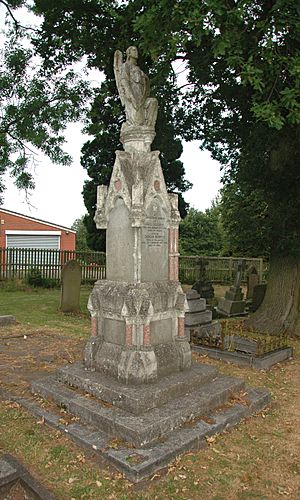
When St. Mary's Church first opened in 1861, its tower had only one bell. In 1864, five more bells were added, making a set of six that could be rung together. They were first rung on September 29, 1864.
In 1887, to celebrate Queen Victoria's Golden Jubilee (50 years as queen), two more bells were added. This made a full set of eight bells, which were first rung on June 20, 1887.
Bells Get a Makeover
By 1922, the bells were not safe to ring. They stayed silent for ten years until enough money was collected to fix them. In 1932, a company called Gillett & Johnston from Croydon melted down and reshaped all eight bells. They were then re-hung in the tower. The largest bell, called the tenor, now weighs about 12 and a half long tons and is tuned to the musical note G.
For many years, starting in the 1930s, the person in charge of the bell ringers was William B. Cartwright, a local lawyer.
What the Bells Say
Two of the bells have special messages written on them in Latin:
- No. 1 Bell (Treble): IN MEMORIAM FILIÆ ET S. M. VICTORIÆ ANNUM QUINQUAGESIMA REGNANTIS D. D. JOEL MERRETT. This means: "Given by Joel Merrett in memory of a daughter and the fiftieth year of the reign of Her Majesty Queen Victoria."
- No. 8 Bell (Tenor): + BEATUS POPULUS QUI SCIT JUBILATIONEM. This means: "Happy are the people who know how to rejoice."
The Church Organ
An organ was first put in St. Mary's in 1862 when the church opened. It was built by a company called Halmshaw. In the 1870s, it was moved to the south side of the chancel.
In 1902, Nicholson and Company rebuilt the organ, but they kept many of the original pipes. It was fixed up again between 1925 and 1930 by Bird of Selly Park.
The organ was restored once more in 1958 by Nicholson & Co. The part where the organist sits, called the console, was moved to the north side of the chancel. The Bishop of Birmingham, John Leonard Wilson, officially dedicated the restored organ on June 4, 1958. A famous organist, Sir George Thalben-Ball, played a concert that day.
More improvements were made to the organ's sound in 1996 and 1999 by Sheffield Organs. As of 2015, John Stormont was still the organist.
The organist is also the choirmaster, and a robed choir helps lead the singing at the main Sunday services. The choir also performs at special events like the Christmas Festival of Lessons and Carols and a passion cantata (a musical story about Jesus's last days) during Holy Week. The church also hosts organ concerts and other musical performances.
The Tower Clock
St. Mary's has a special tower clock that chimes every hour and every quarter hour. It was put in place in 1887, the same year as Queen Victoria's Golden Jubilee.
The clock was made by JB Joyce & Co under the guidance of Rev. Canon Cattley. It works in a similar way to the famous clock at Westminster (Big Ben) and the large clock at Worcester Cathedral. The clock cost about £331, which would be worth around £49,000 today (in 2025). It was a gift from the family of Benjamin Walters.
The clock's frame is made of cast iron and is about 6 feet (1.8 m) long, 1 foot 9 inches (0.5 m) wide, and 1 foot (0.3 m) deep. It's held up by strong beams built into the tower walls to stop it from shaking. The gears are made of gunmetal, and the pendulum swings every 1¼ seconds.
Images for kids
-
Grave and Gothic Revival monument in St Mary's churchyard of Joel and Dorcas Merrett, who died within a month of each other in 1893. Joel Merrett paid for the treble bell in the tower


